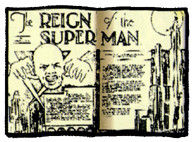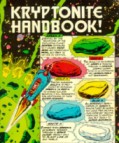
 Look up in the sky. “It’s a bird, it’s a plane, no… it’s Superman!”
Look up in the sky. “It’s a bird, it’s a plane, no… it’s Superman!”
Superman is the brainchild of writer Jerry Siegel and artist Joe Shuster. “Joe and I were high school classmates in Cleveland,” Siegel recalls. “Like me, he was a science fiction fan; we published a fanzine called Science Fiction, with Joe as art director and myself as editor.”  In the January 1933 issue, Siegel’s The Reign of the Superman, illustrated by Shuster, saw print. In this tale, the “Superman” becomes a villain after being granted super-powers by a mad scientist who is very much like the later arch-villain, Lex Luthor.
In the January 1933 issue, Siegel’s The Reign of the Superman, illustrated by Shuster, saw print. In this tale, the “Superman” becomes a villain after being granted super-powers by a mad scientist who is very much like the later arch-villain, Lex Luthor.

Later in 1933, when Siegel saw Detective Dan, one of the first comic books, “it occurred to me that a Superman who was a hero might make a great comic character,” and wrote a comic book story that Shuster drew: The Superman.
After it was rejected by Dan‘s publisher, a dejected Shuster destroyed all of the original art – only the cover survived.
Kryptonite
 The term used to designate any surviving fragment of the exploded planet Krypton, home world of Superman.
The term used to designate any surviving fragment of the exploded planet Krypton, home world of Superman.
There are five distinct varieties of kryptonite (green, red, gold, blue, and white), the first three of which are toxic to Superman.
Green kryptonite, the only variety potentially fatal to Superman, induces lassitude and inertia followed by death if not removed in time from Superman’s presence.
Red kryptonite inflicts bizarre and unpredictable behavior – albeit temporary and nonfatal – symptoms, as when it divides Superman into twins or transforms him into an infant or a giant ant.
Gold kryptonite would permanently rob Superman of his super-powers were he ever to be exposed to its radiation. 
These three varieties of kryptonite are similarly hazardous to Supergirl, Krypto the Superdog, and all other surviving natives of Krypton.
Blue kryptonite is toxic only to Bizarro creatures. White kryptonite is harmful only to plant life. Whenever the word kryptonite appears in this encyclopaedia without a specific color designation, it is green kryptonite, the most common variety, that is being referred to.






























